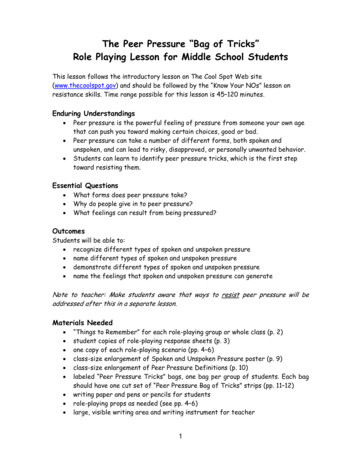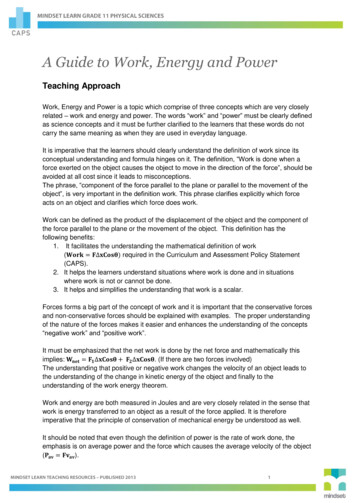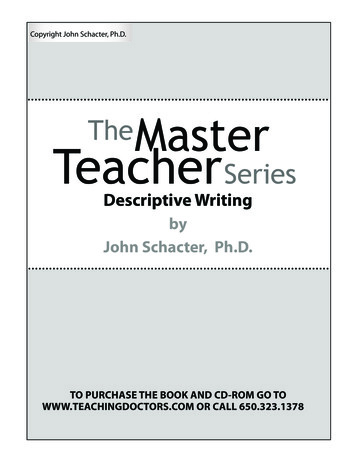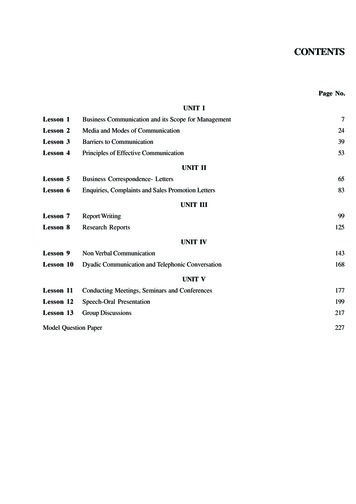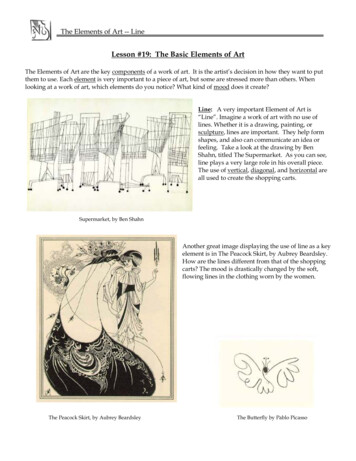
Transcription
The Elements of Art -- LineLesson #19: The Basic Elements of ArtThe Elements of Art are the key components of a work of art. It is the artist’s decision in how they want to putthem to use. Each element is very important to a piece of art, but some are stressed more than others. Whenlooking at a work of art, which elements do you notice? What kind of mood does it create?Line: A very important Element of Art is“Line”. Imagine a work of art with no use oflines. Whether it is a drawing, painting, orsculpture, lines are important. They help formshapes, and also can communicate an idea orfeeling. Take a look at the drawing by BenShahn, titled The Supermarket. As you can see,line plays a very large role in his overall piece.The use of vertical, diagonal, and horizontal areall used to create the shopping carts.Supermarket, by Ben ShahnAnother great image displaying the use of line as a keyelement is in The Peacock Skirt, by Aubrey Beardsley.How are the lines different from that of the shoppingcarts? The mood is drastically changed by the soft,flowing lines in the clothing worn by the women.The Peacock Skirt, by Aubrey BeardsleyThe Butterfly by Pablo Picasso
The Elements of Art -- ColorColor: Artist value “Color” as another important Element of Art. It is a wonderful tool to create mood in a pieceof art. The effect of color can have a strong impact on your feelings. Do you remember the last rainy day, when itwas dark and dreary outside? How did your mood change when sun came back out and lightened everythingup? In art, dark, dreary colors often depict sadness, while cheerful yellows and orange are used for happiness.Dogwood by by Albert BierstadtThe Red Vineyard at Arles, c.1888by Vincent Van GoghParis, a Rainy Day, 1877 by Gustave CaillebotteSunflowers, c.1888by Vincent Van Gogh
The Elements of Art -- ShapeShape: There are a number of different shapes an artist can use to create subject matter.Piet Mondrian, Compostion No. 2Wassily Kandinsky, Merry StructureWhat shapes do you primarily see in the above paintings?Are they soft and round, or more angular and geometrical?What type of feeling does it create? Both Mondrian andKandinsky were famous for their abstract paintings theycreated in the 20th century. Kandinsky’s painting, MerryStructure, definitely lives up to its title. The playful shapescreate a fun image, while Mondrian’s painting is moreserious, consisting of only squares and rectangles.Picasso was another famous painter in the 20th century.Look at all the shapes in his painting, The Lesson. There aretriangles, squares, circles, and many other shapes.Pablo Picasso, The Lesson
The Elements of Art -- TextureTexture: The last Element of Art is “Texture”, which refers to the way the paint feels on the surface of thecanvas. Artists can create texture by using of a paint brush, palette knife, or any type of tool or medium theywould like. Many of the other Elements of Art that we talked about can also be used. Take a look at these twoexamples:Vincent Van Gogh, Starry NightPaul Klee, Ad ParnassemBoth images are great examples of “Texture”. Van Gogh was known for his heavy impasto, created by applyinglots of paint with a brush or even a palette knife. The texture in Starry Night makes the painting look like it hasmovement. French artist, Paul Klee, is famous for his abstract paintings. With color, simple shapes andtextures, Klee is able to make his work interesting and enjoyable to look at. You can see the bumpy texture of thecanvas show through the paint. The following picture is by Georges Seurat. In his painting called, Femmes aubord de l'eau he’s used all dots and dabs of paint to look like women picnicking next to a lake.The Elements of Art that we have discussed are all important in what makes a work of art interesting. Line,Color, Shape, and Texture can be used individually, or combined together to create more impact. It is the artist’sdecision in how they want to use them according to their style of art.
The Elements of Art – Rubbing ActivityActivity #19: Texture Rubbing ActivityThis is a fun and easy project to do at home or in school. You will need to get a piece of 12 x 18” whitedrawing paper and a box of crayons. Fold your paper to make 16 boxes.Open up the paper and grab your crayons. You are now going to look around for objects and surfaces thathave textures that you can feel with your fingertips. Select a dark crayon and place the paper on top of thetexture. Use the SIDE of the crayon and make a rubbing of that texture. Press firmly and fill in the box.When you have finished, go and find another textured surface to rub. Complete a row of four rubbedtextures. Underneath each of those four boxes you are going to try to recreate the texture rubbing using oilpastels. Artists have imitated textures for hundreds of years to give their works a sense of realism or anexpressive element.Once you have completed the second row, go outside and find four natural or environmental textures. Makea rubbing of each one that you find. Try to work neatly, though this can be difficult with very rough textures.Be careful you do not rip the paper. As before, in the next four boxes try to recreate those textures.Words Describing Textures: Fill the space given below with words describing a texture. Come up withgood, descriptive words that go beyond smooth, rough, bumpy, etc.
The Elements of Art -- VocabularyLesson #19: VocabularyImpasto: Applying paint in a heavy manner.Landscape: A picture representing natural scenery, such as trees, lakes, mountains, etc.Element: A part of a whole or one of the parts into which awhole may be resolved.Inspiration: to produce or stir up a feeling, thought, etc.; toinspire confidence in others.Composition: Plan or placement of elements of art in anartwork.Abstract: Of or pertaining to the formal aspect of art,emphasizing lines, colors, generalized or geometricalforms, etc., esp. with reference to their relationship toone another.Expressive: Showing emotion, thought, or feeling.Gallery: A building, an institution, or a room for theexhibition of artwork; a business that displays and sells works of art.Subject Matter: The substance of a discussion, book, artwork, etc., as distinguished from its form or style.Mood: A state or quality of feeling at a particular time.Medium: Type of material used in an artwork, such as oil paint, acrylic, or pastels.Vertical: A line, whether visual or imaginary, that moves up and down.Diagonal: A line, whether visual or imaginary, that runs at angle from lower right to upper left, or upperright to lower leftHorizontal: A line, whether visual or imaginary, that runs from leftto right or right to left.Melancholy: Gloomy state of mind; depressed.Sculpture: The art of carving, modeling, welding, or otherwiseproducing figurative or abstract works of art in three dimensions.
Thomas MoranWestern Painter Thomas MoranThomas Moran became highly recognized for his Western landscapes during the 1800’s. His paintingsbrought awareness to the natural beauty of the land, which many did not believe existed. In 1871, Moranpartnered with photographer, William Henry Jackson, to study the land through the U.S. Geological Surveyof the Territories. During their journey, Moran made sketches and notes of the land along the YellowstoneRiver, while Jackson photographed it. These became proof of what was really in the American wilderness.Thomas Moran:The Tower of Tower FallsWilliam Henry Jackson:At Mammoth Hot Springs inYellowstone
Thomas MoranThroughout northwestern Wyoming and southeastern Montana, Jackson and Moran discovered some ofthe most beautiful land in America. After their expedition, they brought their images to Washington, D.C.to show Congress. They were very impressed. Through Moran and Jackson’s efforts, Yellowstone NationalPark was established on March 1, 1872.Thomas Moran, Grand Canyon of the YellowstoneThomas Moran: CliffdwellersThomas Moran, The Yellowstone RangeThomas Moran: Hopi Village
Thomas MoranGrand Canyon of Arizona from Hermit Rim Road
Georgia O’KeefeSouthwestern Painter Georgia O’KeefeKnown for her beautiful interpretation of flowers and southwestern landscapes, Georgia O’Keefedefinitely stands out as one of most influential artists of the 20th century. Born in 1887, in ourneighboring city of Sun Prairie, Wisconsin, O’Keeffe longed to be an artist from an early age. In 1905she attended the Art Institute of Chicago and a year later went to study at the Art Students League ofNew York. She worked briefly in Chicago before moving to Texas to teach.During O’Keeffe’s stay in Texas, she made a handful of charcoal drawings for her friend, AnnaPollitzer in New York. Anna was very impressed with her work, so she showed them to AlfredStieglitz, a photographer and gallery owner. He was enthused with the vibrant energy of her drawingsand asked to show them. So, without her knowledge, Georgia O’Keeffe had her first exhibition in 1916at Steiglitz’s “291 Gallery.” Within two years, Steiglitz had convinced O’Keeffe to move to New Yorkand devote all of her time to painting. He began exhibiting her work more frequently, which increasedher popularity. Their close relationship led to marriage six years later.No.13 Special, 1916No. 5 Special, 1916Abstraction, 1916
Georgia O’KeefeLiving in New York City, O’Keeffe painted some of her most famous work. During the 1920s, her large,over-powering flowers filled the canvasses with dynamic energy, along with her dramatic cityscapes.In 1929 O’Keeffe took a vacation with her friend Beck Strand to Taos, New Mexico. The trip wouldforever change the course of her life. She fell in love with the open skies and colorful landscapes. Shelonged to escape the city life and continued her vacations there every summer. When Steiglitz died in1946, O’Keeffe took up permanent residence in New Mexico. These early New Mexico landscapes andstill-lifes demonstrate her incredible talent. The rich colors and organic shapes were similar to herpowerful representations of flowers.Oriental PoppyJimson Weed, 1932White Flower, 1929Black Hollyhock, Blue Larkspur
Georgia O’KeefeThroughout O’Keefe’s lifetime, she was presented with numerous art awards. In 1985, President Reagangranted her the National Medal of Arts. The following year, O’Keeffe passed away at St. Vincent’s Hospitalin Santa Fe, New Mexico. She was 98 years old. Georgia O’Keeffe’s work remains an important part of arthistory and serves as an inspiration to many.1944 - Black Hills I1944 - Cottonwood III1941 - Series near Abiquiu, New MexicoCliffs Beyond Abiquiu, Dry WaterfallRam’s Head White Holly Hock Hills
Georgia O’KeefeGeorgia O’Keefe ActivityGrade Level: 3rd GradeAnticipated Tine Period: Two- 45 minute class periodsGoal: Students will be knowledgeable of the style and composition in Georgia O’Keefe’s Work.Objectives:1. Students will discuss the characteristics of Georgia O’Keefe’s Work.2. Students will observe a floral arrangement to plan a composition of a flower that extends all foursides of the page.3. Students will use crayon to add color, shade and value to their flowers.VocabularyValue: The lightness of darkness of a color.Composition: The way shapes and forms are arranged on the picture plane.Nature: The living things that we find outside in our environment. Things that are notmanmade, such as the earth, sky, animals, and plants.Organic shapes: Free-flowing shapes found in nature.Abstract: Artwork that has been broken down so as not to be recognizable. Nonrepresentational art.Materials:1.Examples of Georgia O’Keefe’s work2.Teacher’s personal artwork inspired by O’Keefe3.9x12” paper4.Pencils5.Crayons6.Fresh flowers, one vase per table
Teacher Preparation:Prepare room with floral arrangements and supplies on every table, examples displayed, andvocabulary written on board.Motivation:1. Show the class some artwork that Georgia she has done. Ask students where they thinkshe got her inspiration. Explain that Georgia loved to paint things from nature. Showsome of her paintings of the city. Explain that she used to live in the city, but did not likeit. Explain that she was married to a famous photographer named Alfred Stieglitz. Showher painting of the dessert. Explain how she moved west and loved to paint what shesaw around her.Show examples of O’Keefe’s flowers. Describe how the petals are huge and that she“zoomed in” close up to show details.2.Have students identify elements of art in O’Keefe’s work using art vocabulary.3.Process and Procedures:1.2.Using art vocabulary, demonstrate how to draw a composition using flowers as subjectmatter.Demonstrate how to zoom in using your hands to crop the view.3. Students will be seated in groups of four and will “zoom in” find ancomposition.4.interestingThey will first draw their composition with pencil and then apply crayon when enoughcontour lines are done. They will use value to depict folds and depth.5. Monitor students and hold up good examples. Encourage filling thecomposition andmaking sure to look and see what is in between the petals. “ Can you see another floweror a stem?”Clean Up:Students will make sure their names are on their paper and one person will be called on tocollect work. Other students will be chosen to help clean up materials.
Closure:1. Students will review the vocabulary and techniques they have learned.2. Students will tell what they know about Georgia O’Keefe’s life and what inspiredher.Assessment:Evaluate students based on objectives met.Teacher Reflection:Make sure to use sturdy containers as a vase for flowers.Georgia O’Keefe: Two Calla Lilies on Pin
Georgia O’Keefe - VocabularyVocabulary ReferenceImpasto: Applying paint in a heavy manner.Landscape: A picture representing natural scenery, such as trees, lakes, mountains, etc.Element: A part of a whole or one of the parts into which a whole may be resolved.Inspiration: to produce or stir up a feeling, thought, etc.; to inspire confidence in others.Composition: Plan or placement of elements of art in an artwork.Abstract: Of or pertaining to the formal aspect of art, emphasizing lines, colors, generalized orgeometrical forms, etc., esp. with reference to their relationship to one another.Expressive: Showing emotion, thought, or feeling.Gallery: A building, an institution, or a room for the exhibition of artwork; a business thatdisplays and sells works of art.Subject Matter: The substance of a discussion, book, artwork, etc., as distinguished from its formor style.Mood: A state or quality of feeling at a particular time.Medium: Type of material used in an artwork, such as oil paint, acylic, or pastels.Vertical: A line, whether visual or imaginary, that moves up and down.Diagonal: A line, whether visual or imaginary, that runs at angle from lower right to upper left, orupper right to lower leftHorizontal: A line, whether visual or imaginary, that runs from left to right or right to left.Melancholy: Gloomy state of mind; depressed.Sculpture: The art of carving, modeling, welding, or otherwise producing figurative or abstractworks of art in three dimensions.
Artist Matching GameArtist Matching GameDraw a line from the picture to the correct artist. If you need help, look back in your oghThomasMoran
Lesson #19: The Basic Elements of Art The Elements of Art are the key components of a work of art. It is the artist’s decision in how they want to put them to use. Each element is very important to a piece of a




